
views
Getting a Medical Examination
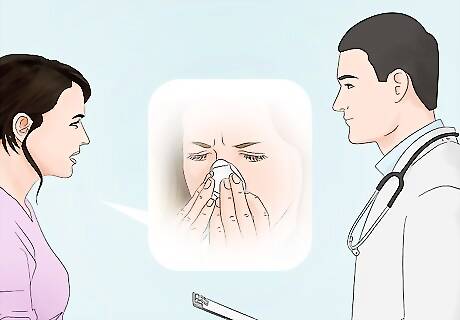
Ask your doctor about mold exposure and describe your symptoms. There is no need to worry about life-threatening conditions after an exposure to mold—especially if you aren’t allergic. To determine whether mold exposure is actually causing you harm, schedule an appointment with your primary care doctor. Show up and describe the symptoms that you’re experiencing.Tip: There is no such thing as “toxic mold.” There are toxigenic molds that can promote the growth of dangerous bacteria, but these molds are quite rare. The mold itself isn’t dangerous if the bacteria growing on it is safe. There is no way to determine whether mold is harboring dangerous bacteria or not without getting it tested by a laboratory. Don’t assume that you need to run off to the doctor as soon as you see mold. If you aren’t experiencing any symptoms and you’re not allergic, there isn’t any cause for serious concern so long as you have the mold removed. Mold (such as coccidioides) can grow in certain soils, and it's possible to inhale the spores and develop pneumonia. This can cause flu-like symptoms that last for weeks to months. It's most common in the southwestern United States (California and Arizona), as well as parts of Mexico, Central America, and South America, and you don't need to worry about it if you don't live in these areas. If you have an allergy to mold, your symptoms may include sneezing, itchy eyes, coughing, and wheezing. According to the CDC, all types of mold should be treated with the same degree of seriousness. See your doctor if you have symptoms of an allergy or illness, and take steps to clean the mold, regardless of what type of mold it is. You should seek medical help immediately if you experience shortness of breath, chest pain, memory loss, or lethargy after a prolonged exposure to mold. Some bacteria can build up in your lungs and cause infections if you’re exposed to mold for too long. These infections are extremely rare, though. The treatments for mold-based infections are typically steroids or antibiotics. The private companies and labs that perform tests for “toxic mold exposure” tend to be pseudoscientific and unreliable. Consult your doctor first before going to a private company for testing.
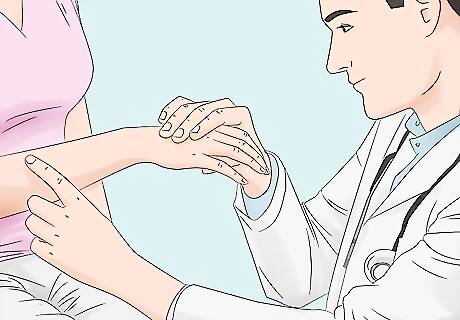
Get examined and express your concern about mold exposure. Allow your doctor to examine you and answer any of their questions. During your examination, tell your doctor that you’re worried about mold exposure. It’s possible that you may have an allergy to mold, and your doctor will be able to answer any of your questions and take a closer look at your skin, eyes, and nasal passages. While mold can be a lung irritant in people that are not allergic to it, the medical consensus is that mold exposure is not life-threatening. In most cases, you can remove the mold from your environment and your symptoms will clear up.

Get a referral for an allergy specialist from your primary care doctor. If your doctor is concerned that you have an allergy to mold, ask to get a test to confirm your allergy. If your doctor believes that it is appropriate, they will refer you to an allergy specialist. Follow your doctor’s post-care instructions to ensure that your symptoms do not get worse. Your doctor may tell you to take antihistamines or decongestants to curb your symptoms. Keeping your windows closed and running a dehumidifier will also help curb symptoms from a mold allergy. Some primary care doctors will be able to perform the allergy test in their office.
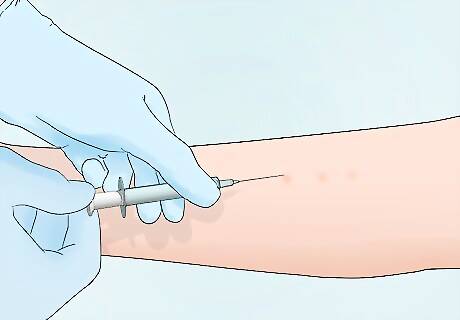
Take a skin test to determine whether you’re allergic to mold or not. Go to your allergy specialist’s office and explain that you need a skin test for a mold allergy. The allergy specialist will apply a small amount of concentrated mold and study your skin’s reaction. If you are allergic, the doctor will prescribe a steroid, antihistamine, or decongestant to help your symptoms. If the mold is in your home, you will need to remove it by either hiring a professional mold removal company or removing the mold and repairing the affected rooms, floors, or areas. There is a blood test for mold exposure, but the skin test is the most common form of the test.
Taking a Mycotoxin Test
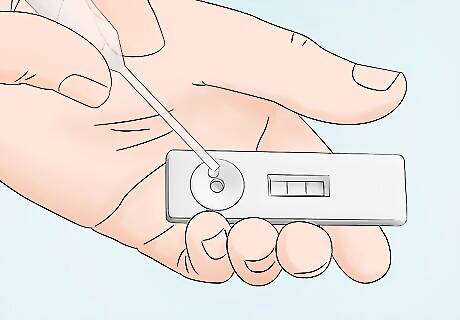
Ask your doctor or allergy specialist for a mycotoxin diagnostic test. If you really want a more in-depth picture of your mold exposure, ask your doctor or allergy specialist for a mycotoxin test. Mycotoxins are toxic compounds that grow and feed on mold, and may be the source of your symptoms if you’ve been exposed to mold for an extended period of time.Tip: Your doctor may recommend against a mycotoxin test. Mycotoxin tests tend to be unreliable and difficult to interpret. There is also a serious debate in the medical community over whether mycotoxins are dangerous when present in small amounts. You're more likely to be exposed to mycotoxins if you work in agriculture, and it's considered an occupational risk. It's best to take precautions to limit your exposure. The only type of mold that produces mycotoxins in high amounts is stachybotrys, which is commonly known as “black” mold. They can often grow on moldy food as well. There are 3 major mycotoxins: trichothecenes, aflatoxins, and ochratoxins. Your test may break your results down into these subcategories.
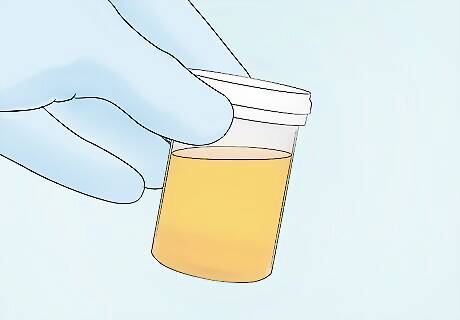
Take your urine, nasal, or tissue sample test to determine your exposure. This test done may be completed by your doctor or your allergy specialist, but you’ll probably be sent to a private laboratory or diagnostic office for the exam. There are 3 different forms of the test, so either submit your urine sample, nasal tissue, or allow the clinician to inspect your skin and hair. There is no major difference between the 3 tests in terms of the results.
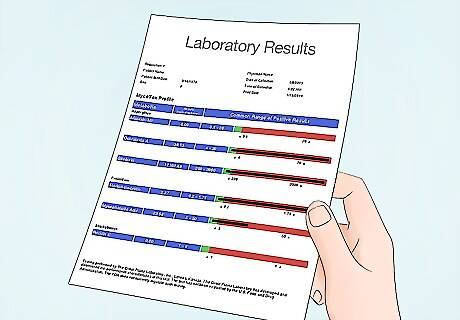
Wait to receive your results from the laboratory. After you’ve submitted your sample, wait 1-6 weeks for the lab to process your results. In the meantime, follow your doctor’s after-care instructions and limit your exposure to damp rooms, expired food, and humidity. Mold particles are everywhere, so you may not be able to limit your exposure completely. Staying in dry areas and eating a healthy diet is a great way to limit your exposure to mold.
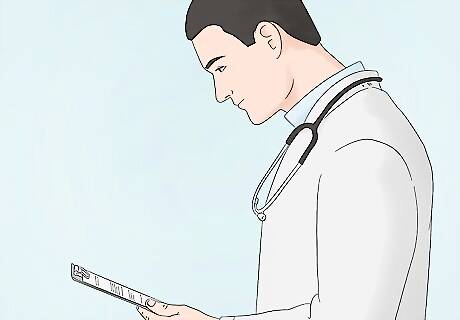
Bring your results to your primary care doctor for next steps. When you receive your results, schedule another appointment with your primary care doctor. Show up for the appointment and share your results with the doctor. They will be able to refer you to a specialist and go over your results with you. If you do have an issue with mycotoxin exposure, the treatments include oxygen therapy, nutritional changes, and immunotherapy.
Testing Your Home for Mold
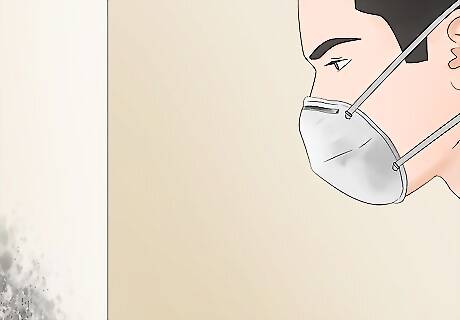
Perform a visual inspection in your home to look for mold. Put on a dust mask and a pair of rubber gloves. Go around your home and inspect the walls, ceilings, and floor. Look for discolored floorboards and drywall. Inspect your basement thoroughly and look under your crawl space if you have one. Note any locations where you find black, red, or brown residue.Tip: If your mycotoxin test came back positive, keep a keen eye out for black molds. Black mold is the only commonly-found mold that produces mycotoxins. Be sure to check behind your refrigerator, in your air vents, and behind large pieces of furniture. Mold usually looks like a dusty debris that clings to moist or damp surfaces. It may look fuzzy or wet. Pay attention to the smell in the air. Mold has a distinctive scent and it often smells like wet leaves or soil.
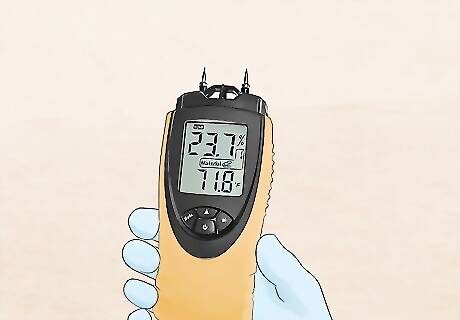
Use a moisture meter to find areas in your home that will attract mold. A moisture meter cannot detect mold on its own, but it does an excellent job at narrowing down where mold will grow. Purchase a moisture meter online or in a construction supply store. Turn it on and walk it around your home to read the moisture levels in the air. Moisture meter results are color-coded, and any room that shows up in the green is unlikely to cultivate mold. The yellow category means that the moisture levels are higher than average. Red is a sign that you have serious moisture problems in the area. To reduce moisture in a room, improve the ventilation by turning a fan on and put a dehumidifier in the room.

Hire a professional lab service to confirm suspicious discoloration as mold. To confirm the existence of mold in your home, hire a professional mold testing company to inspect your building. A professional service is the only surefire way to determine whether or not mold is an issue in your home. If they do find mold, they will be able to determine the best course of action to remove the problematic fungus. A professional testing surface will cost $100-300, but it’s the only way to diagnose your mold problems accurately.
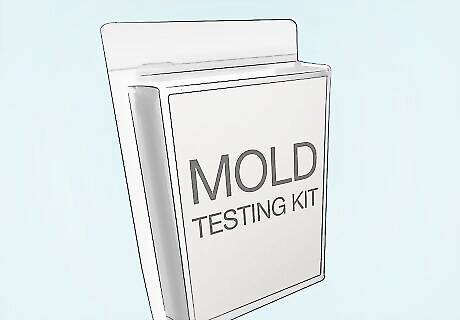
Purchase a mold testing kit to test your home on your own. DIY mold testing kits are commonly sold for $20-60. Purchase a kit online or at a construction supply store. To use one of these kits, unpack the materials and read the instructions carefully. Usually, you leave a small petri dish out in an enclosed room for 24-48 hours. The chemical in the petri dish will absorb mold particles from the air. Put a lid on the dish and seal it. Check it after 2-4 days to see if mold has grown inside the dish. DIY kits are less reliable than a professional service when it comes to identifying mold. If mold grows inside the dish, you have a high percentage of mold in your air. You can send the dish to get tested at the manufacturer’s lab. Getting the sample tested will cost an additional $20-100. If no mold grows, the odds that you have mold in your home are low.

Scrub mold with soap and water or replace the moldy surfaces. If you have a moldy object or piece of furniture, throw it out. If you have a small infestation, put on gloves and a dust mask. Scrub the surface with 1-part dish soap and 3-parts water. Let the surface dry out under a fan and repeat the process until the mold is completely gone. Scrub moldy tiles or caulk scrubbed clean with soap and water. Don’t paint over mold. The mold will simply reappear after the paint has dried.
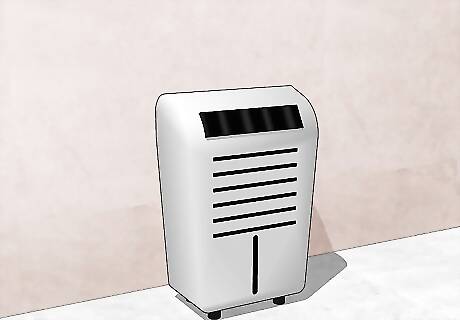
Prevent mold by using a dehumidifier to remove dampness. Mold needs a moist environment to grow, so you may be able to prevent mold by keeping your home dry. Use a dehumidifier to remove the moisture in your home, especially in your bathroom and basement. Additionally, make sure your bathroom ventilation system is working so the moisture doesn't linger. Don't put carpet in a bathroom because it traps moisture and provides a breeding ground for mold.Tip: It's especially important to use a dehumidifier if your home floods. Mold can develop within 24-48 hours after a flood event.


















Comments
0 comment